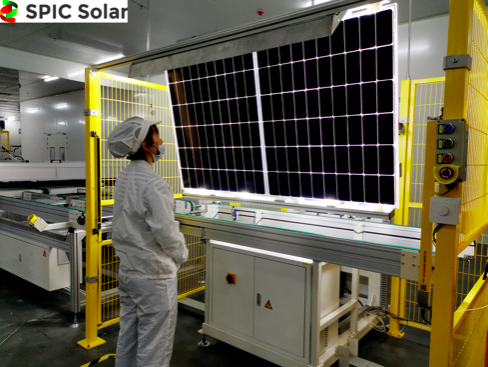
Over recent years, PV industrialization technology has developed rapidly, with innovations made across all production links, especially the marked improvement in crystal pulling technology in the silicon wafer production area. With the application of diamond wire cutting technology and large-size thin silicon wafers, the production cost of monocrystalline silicon wafers will decrease rapidly, and the price of polycrystalline silicon wafers will gradually decline.
In addition, the increase in demand for high-power modules has fuelled the rapid development of the monocrystalline silicon industry, thus ushering in the beginning of the monocrystalline era from that of polycrystalline.
As we all know, in order to ensure the competitiveness of PV power generation, the key lies in improving efficiency and reducing costs. PERC technology, originating from the innovation and development of traditional Al-BSF technology, has improved the conversion efficiency of monocrystalline modules to over 22.0% with its excellent passivation effect, and has brought significant economic benefits, thus bringing about the full advent of the PERC era.
After PERC, what will be the leading technology of the next generation?
It is understood that most efficient new technologies which have gained significant support in the market are represented by bifacial N-PERT, TOPCon, Interdigitated Back Contact (IBC) and Heterojunction with Intrinsic Thin-layer (HJT) modules. Companies have already taken a stand on different technological routes and announced that mass production will be implemented.
Among new technologies, N-IBC has been praised as the “king of conversion efficiency”. Most records on highest module efficiency in the global industry are related to it, and it currently holds the world record on conversion efficiency for crystalline silicon modules.
For IBC cell – interdigitated back contact crystalline silicon PV modules, both positive and negative metal contacts are designed on the back of the module, so that the front surface of the module facing the sun has no shade, and the problem of shading by front metal grid lines in the traditional cell structure is avoided. This kind of module not only has a larger effective power generation area which maximises conversion efficiency, but is also the most aesthetically pleasing module.
State Power Investment Corporation Limited ( SPIC ), ranking first in the world in terms of PV installed capacity, officially announced the layout of N-type IBC technology last year.
In August 2018, SPIC Solar cut over its first module production line in China, with mass production capacity of 200 MW N-IBC cells and modules at more than 23% efficiency. As a result, HuangHe HydroPower Development Co.,LTD. (SPIC Solar) officially entered the international field of high-efficiency PV modules at an advanced level.
Xie Xiaoping, the CEO of Huanghe HydroPower Development/SPIC Solar, said that the company supports the intelligent upgrade and application of clean energy. Focusing on research and development of high-efficiency PV modules such as N-IBC, the company plans to achieve a cell conversion efficiency of 23% by the end of 2019 and an efficiency of more than 25% by 2025, placing it at the forefront of technological development in the industry.
The development of new technology in the PV industry is becoming increasingly rapid. To be an industry leader, it is not enough to merely keep up with general trends and Huanghe HydroPower/SPIC, a state-owned organisation, aims to take the lead in improving its capabilities, delivering increasingly innovative products and establishing itself as a world-class PV company.
Given this ambition, the company has launched the R&D of N-type high-efficiency cell technology, entering into co-operation with internationally renowned research bodies such as the German Solar Energy Research Center in Konstanz and the Solar Energy Research Institute of Singapore (SERIS), to develop technologies in the N-PERT, TOPCon and IBC areas.
N-PERT and TOPCon products have already been put into mass production, while IBC bifacial modules were successfully rolled off the production line in October 2019, and have been approved in the IEC 61215/61730:2016 standard test. The Huanghe Company has therefore become the first PV enterprise in China to have its IBC bifacial module certified to TÜV Rheinland’s new IEC standard.
For its N-IBC development project, Huanghe/SPIC has also registered a total of 48 patents covering IBC cells and modules to protect its position against competition.
Huanghe/SPIC’s promotion of N-IBC high-efficiency cells has attracted wide attention within the industry and, with the largest PV installed capacity in the world and a 100MW level demonstration base, the company’s technology developments are having an impact not only on the selection criteria of 80% of top customers globally but also, to a certain degree, on the development trend of advanced PV technology as a whole.
